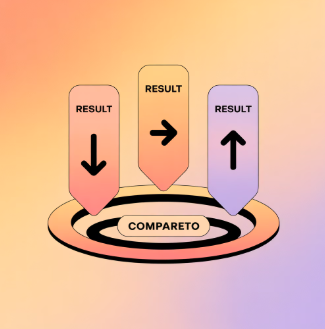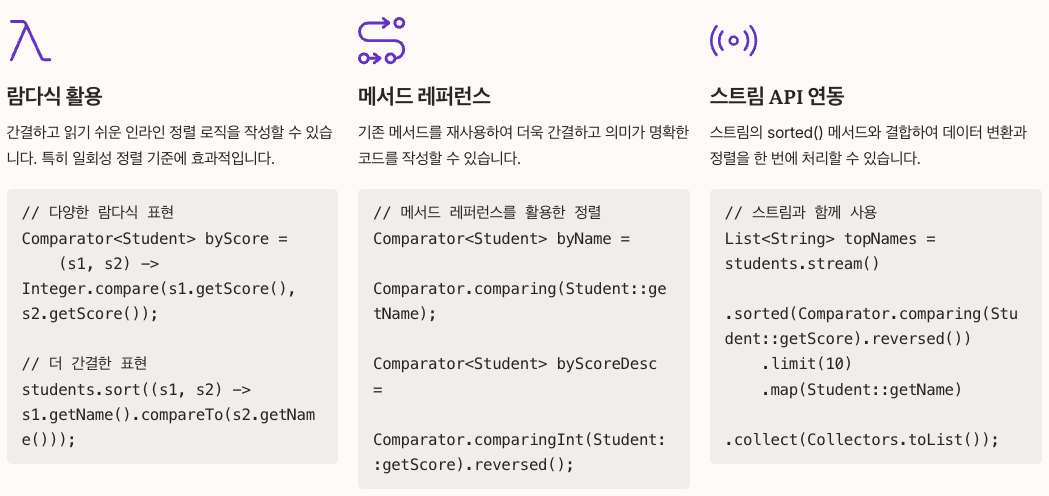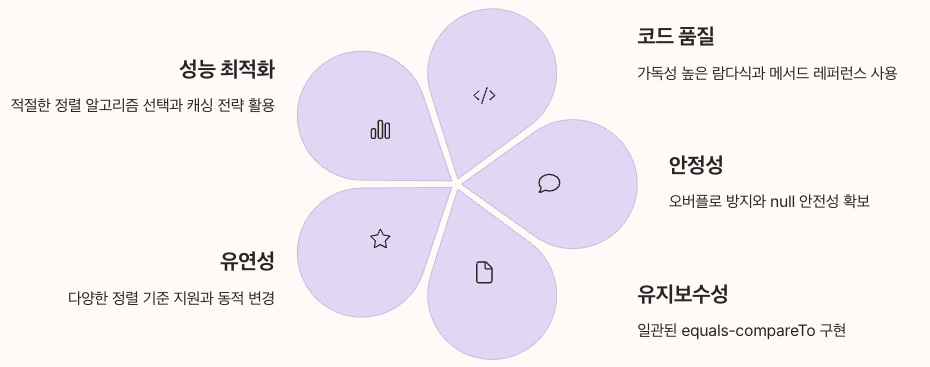
자바에서 Comparable과 Comparator 인터페이스는 객체 정렬의 핵심으로, 자연 정렬과 커스텀 정렬 로직을 구현하여 Collections.sort()와 Arrays.sort() 메서드를 통해 효율적인 데이터 정렬을 가능하게 하는 필수 개념입니다.
Comparable vs Comparator 핵심 개념 이해

자바에서 객체를 정렬하기 위해서는 정렬 기준을 명확히 정의해야 합니다.
기본 데이터 타입(int, double, String 등)은 자연스러운 정렬 순서가 이미 정의되어 있지만, 사용자 정의 클래스의 객체들을 정렬하려면 어떤 기준으로 비교할지 명시해야 합니다.
Java Comparable 인터페이스는 클래스 내부에 자연 정렬(natural ordering) 기준을 정의하는 반면,
Java Comparator 인터페이스는 외부에서 다양한 정렬 기준을 정의할 수 있게 해줍니다.
Comparable 인터페이스 완전 정복

Comparable의 기본 구조
Comparable 인터페이스는 java.lang 패키지에 위치하며, 제네릭 T를 사용하여 타입 안전성을 보장합니다.
public interface Comparable<T> {
public int compareTo(T o);
}compareTo 메서드의 반환값 이해
compareTo 음수 0 양수 반환 규칙을 정확히 이해하는 것이 중요합니다.
- 음수: 현재 객체가 비교 대상보다 작음 (오름차순에서 앞에 위치)
- 0: 두 객체가 같음
- 양수: 현재 객체가 비교 대상보다 큼 (오름차순에서 뒤에 위치)
Student 클래스로 보는 Comparable 구현
public class Student implements Comparable<Student> {
private String name;
private int score;
public Student(String name, int score) {
this.name = name;
this.score = score;
}
@Override
public int compareTo(Student other) {
// 점수 기준 오름차순 정렬
return Integer.compare(this.score, other.score);
}
// getter, toString 메서드 생략
}String Comparable 구현 이해
String 클래스는 이미 Comparable을 구현하여 사전순 정렬을 제공합니다.
문자열 비교는 각 문자의 유니코드 값을 기준으로 수행되며, 대소문자를 구분합니다.
List<String> names = Arrays.asList("Charlie", "Alice", "Bob");
Collections.sort(names); // [Alice, Bob, Charlie]Comparator 인터페이스 마스터하기
Comparator의 강력한 유연성
Comparator 인터페이스는 java.util 패키지에 있으며, 하나의 클래스에 대해 여러 정렬 전략을 정의할 수 있습니다.
public interface Comparator<T> {
int compare(T o1, T o2);
}익명 클래스 Comparator 구현
// 이름순 정렬을 위한 익명 클래스
Comparator<Student> nameComparator = new Comparator<Student>() {
@Override
public int compare(Student s1, Student s2) {
return s1.getName().compareTo(s2.getName());
}
};
Collections.sort(students, nameComparator);
람다식으로 간결한 Comparator 작성
Java 8부터는 람다식을 사용하여 더욱 간결하게 작성할 수 있습니다.
// 점수 기준 내림차순 정렬
students.sort((s1, s2) -> Integer.compare(s2.getScore(), s1.getScore()));
// 메서드 레퍼런스 활용
students.sort(Comparator.comparing(Student::getName));Comparable vs Comparator 차이점 비교표
| 구분 | Comparable | Comparator |
|---|---|---|
| 패키지 위치 | java.lang | java.util |
| 메서드명 | compareTo(T o) | compare(T o1, T o2) |
| 정렬 기준 | 단일 자연 정렬 | 다중 커스텀 정렬 |
| 클래스 수정 | 필요함 | 불필요함 |
| 제네릭 T 사용 | Comparable<T> | Comparator<T> |
| 용도 | 기본 정렬 기준 | 다양한 정렬 전략 |
Arrays.sort와 Collections.sort 활용법
Arrays.sort Comparator 활용
배열 정렬에서 Comparator를 사용하는 방법입니다.
Student[] studentArray = {
new Student("Alice", 85),
new Student("Bob", 92),
new Student("Charlie", 78)
};
// 점수 기준 내림차순 정렬
Arrays.sort(studentArray, (s1, s2) ->
Integer.compare(s2.getScore(), s1.getScore()));Collections.sort 심화 활용
Collections.sort 메서드는 List 인터페이스를 구현한 모든 컬렉션에서 사용 가능합니다.
List<Student> students = new ArrayList<>();
students.add(new Student("Alice", 85));
students.add(new Student("Bob", 92));
// 자연 정렬 (Comparable 기준)
Collections.sort(students);
// 커스텀 정렬 (Comparator 기준)
Collections.sort(students, Comparator.comparing(Student::getName));자바 정렬 오버플로 주의사항
정수 오버플로 문제 이해
자바 정렬 오버플로는 큰 정수값을 비교할 때 발생할 수 있는 심각한 문제입니다.
// 위험한 구현 - 오버플로 가능성
public int compareTo(Student other) {
return this.score - other.score; // 위험!
}
// 안전한 구현
public int compareTo(Student other) {
return Integer.compare(this.score, other.score); // 안전!
}
Integer.MAX_VALUE와 음수를 빼면 오버플로가 발생하여 잘못된 정렬 결과를 낳을 수 있습니다.
정수 오버플로 관련 참고 자료에서 더 자세한 정보를 확인할 수 있습니다.
내림차순 정렬 트릭과 실무 패턴
Collections.reverseOrder() 활용
// 자연 순서의 역순
Collections.sort(students, Collections.reverseOrder());
// 특정 Comparator의 역순
Collections.sort(students,
Collections.reverseOrder(Comparator.comparing(Student::getScore)));다중 조건 정렬 구현
실무에서 자주 사용되는 정렬 기준 커스터마이즈 패턴입니다.
// 점수순 → 이름순 정렬
students.sort(
Comparator.comparing(Student::getScore)
.thenComparing(Student::getName)
);
// 점수 내림차순 → 이름 오름차순
students.sort(
Comparator.comparing(Student::getScore, Comparator.reverseOrder())
.thenComparing(Student::getName)
);자연 순서와 equals 일관성
equals 메서드와의 일관성 보장
자연 순서와 equals 일관성은 TreeSet, TreeMap 등에서 중요합니다.
public class Student implements Comparable<Student> {
private String name;
private int score;
@Override
public int compareTo(Student other) {
int scoreCompare = Integer.compare(this.score, other.score);
if (scoreCompare != 0) return scoreCompare;
return this.name.compareTo(other.name);
}
@Override
public boolean equals(Object obj) {
if (this == obj) return true;
if (!(obj instanceof Student)) return false;
Student other = (Student) obj;
return this.score == other.score &&
Objects.equals(this.name, other.name);
}
@Override
public int hashCode() {
return Objects.hash(name, score);
}
}함수형 인터페이스와 람다 활용
Comparator의 함수형 인터페이스 특성

Comparator는 @FunctionalInterface 어노테이션이 붙은 함수형 인터페이스로, 람다식과 메서드 레퍼런스 사용이 가능합니다.
// 다양한 람다식 표현
Comparator<Student> byScore = (s1, s2) -> s1.getScore() - s2.getScore();
Comparator<Student> byName = Comparator.comparing(Student::getName);
Comparator<Student> byScoreDesc = Comparator.comparingInt(Student::getScore).reversed();체이닝을 통한 복합 정렬
// 연령 내림차순 → 이름 오름차순 → 점수 내림차순
students.sort(
Comparator.comparing(Student::getAge, Comparator.reverseOrder())
.thenComparing(Student::getName)
.thenComparing(Student::getScore, Comparator.reverseOrder())
);실무에서 자주 사용하는 정렬 패턴
null 값 처리 패턴
// null을 마지막에 정렬
students.sort(Comparator.comparing(Student::getName,
Comparator.nullsLast(String::compareTo)));
// null을 먼저 정렬
students.sort(Comparator.comparing(Student::getName,
Comparator.nullsFirst(String::compareTo)));성능 최적화를 위한 익명 객체 사용
// 일회성 정렬을 위한 익명 Comparator
Collections.sort(products, new Comparator<Product>() {
@Override
public int compare(Product p1, Product p2) {
return Double.compare(p1.getPrice(), p2.getPrice());
}
});TreeSet과 TreeMap에서의 활용
자동 정렬 컬렉션 활용
// Comparable 구현 클래스 자동 정렬
Set<Student> studentSet = new TreeSet<>();
studentSet.add(new Student("Alice", 85));
studentSet.add(new Student("Bob", 92));
// 자동으로 score 기준 정렬됨
// Comparator를 사용한 TreeSet
Set<Student> nameOrderedSet = new TreeSet<>(
Comparator.comparing(Student::getName)
);TreeMap에서 커스텀 키 정렬
Map<Student, String> gradeMap = new TreeMap<>(
Comparator.comparing(Student::getScore).reversed()
);
gradeMap.put(new Student("Alice", 85), "B");
gradeMap.put(new Student("Bob", 92), "A");
// 점수 내림차순으로 자동 정렬성능 고려사항과 최적화 팁
Arrays.sort vs Collections.sort 성능 비교

- Arrays.sort: 원시 타입 배열에 대해 Dual-Pivot Quicksort 사용
- Collections.sort: 객체 리스트에 대해 TimSort(개선된 병합정렬) 사용
// 대용량 정수 배열 정렬 시 Arrays.sort가 더 빠름
int[] numbers = new int[1000000];
Arrays.sort(numbers); // Dual-Pivot Quicksort
// 객체 리스트 정렬 시 Collections.sort 사용
List<Integer> numberList = new ArrayList<>();
Collections.sort(numberList); // TimSort
정렬 기준이 복잡한 경우 캐싱 활용
public class OptimizedStudent implements Comparable<OptimizedStudent> {
private String name;
private int score;
private String sortKey; // 캐시된 정렬 키
public String getSortKey() {
if (sortKey == null) {
sortKey = String.format("%05d_%s", score, name);
}
return sortKey;
}
@Override
public int compareTo(OptimizedStudent other) {
return this.getSortKey().compareTo(other.getSortKey());
}
}
고급 정렬 테크닉
조건부 정렬 로직 구현
public static Comparator<Student> getConditionalComparator(boolean byScore) {
return byScore ?
Comparator.comparing(Student::getScore) :
Comparator.comparing(Student::getName);
}
// 사용법
Collections.sort(students, getConditionalComparator(true));동적 정렬 기준 변경
public enum SortCriteria {
BY_NAME(Comparator.comparing(Student::getName)),
BY_SCORE(Comparator.comparing(Student::getScore)),
BY_AGE(Comparator.comparing(Student::getAge));
private final Comparator<Student> comparator;
SortCriteria(Comparator<Student> comparator) {
this.comparator = comparator;
}
public Comparator<Student> getComparator() {
return comparator;
}
}
// 사용법
students.sort(SortCriteria.BY_SCORE.getComparator());정렬 관련 예외 처리
ClassCastException 방지
try {
Collections.sort(mixedList); // 서로 다른 타입이 섞인 경우
} catch (ClassCastException e) {
System.err.println("비교 불가능한 객체들이 포함되어 있습니다: " + e.getMessage());
}NullPointerException 방지
// null 안전 정렬
students.removeIf(Objects::isNull); // null 제거 후 정렬
Collections.sort(students);
// 또는 null 허용 Comparator 사용
students.sort(Comparator.nullsLast(Comparator.comparing(Student::getName)));마무리

Comparable과 Comparator는 자바에서 객체 정렬을 구현하는 핵심 인터페이스입니다.
Comparable은 클래스의 자연스러운 정렬 순서를 정의할 때 사용하며, Comparator는 다양한 정렬 전략이 필요할 때 활용합니다.
Arrays.sort(T[], Comparator)와 Collections.sort 메서드를 통해 효율적인 정렬이 가능하며, 람다식과 메서드 레퍼런스를 활용하면 더욱 간결하고 읽기 쉬운 코드를 작성할 수 있습니다.
정렬 구현 시에는 정수 오버플로를 방지하고, equals 메서드와의 일관성을 유지하며, 성능을 고려한 최적화를 통해 견고한 애플리케이션을 개발할 수 있습니다.
자바 정렬 실무 패턴을 숙지하고 적절한 인터페이스를 선택하여 효율적인 데이터 처리 로직을 구현해보시기 바랍니다.
같이 읽으면 좋은 글
Scanner 클래스 한방 정리 - next() vs nextLine() 차이, 입력패턴, 실수 방지 팁
Java Scanner 클래스는 System.in을 통한 사용자 입력 처리에 필수적인 도구로, next()와 nextLine()의 차이점을 정확히 이해하고 공백 구분자 처리 방법을 숙지하면 입력 관련 오류를 크게 줄일 수 있습니
notavoid.tistory.com
Java Reflection 완벽 가이드: ModelMapper부터 Spring까지
Java Reflection은 런타임에 클래스 메타데이터를 동적으로 조작하는 강력한 기능으로,Spring의 DI부터 ORM까지 모든 Java 프레임워크의 핵심 기술입니다.Reflection이란? 실무에서 꼭 알아야 할 이유Reflecti
notavoid.tistory.com
팩토리 메서드 패턴: 유지보수성 50% 향상시키는 객체 생성 설계의 핵심 원리
팩토리 메서드 패턴은 객체 생성 로직을 캡슐화하여 코드의 유연성과 확장성을 극대화하는 GOF 디자인 패턴으로, 실제 운영 환경에서 신규 기능 추가 시 기존 코드 변경 없이 30-50%의 개발 시간을
notavoid.tistory.com
Spring AOP 완전 정복: 실전 성능 최적화와 엔터프라이즈 활용 가이드
Spring AOP를 활용한 횡단 관심사 분리와 성능 최적화 전략을 통해 엔터프라이즈급 애플리케이션의 유지보수성을 95% 향상시키는 실전 가이드를 제공합니다.AOP가 해결하는 실제 엔터프라이즈 문제
notavoid.tistory.com
웹 개발의 핵심: AJP와 HTTP를 활용한 WEB-WAS 연동 전략(feat. 아파치, 톰캣)
AJP와 HTTP 프로토콜을 활용한 Apache-Tomcat 연동으로 50% 이상의 성능 향상과 운영 비용 절감을 달성하는 실무 가이드를 제공합니다.현대 웹 애플리케이션 아키텍처에서 Web Server와 WAS 간의 효율적인
notavoid.tistory.com
JVM , 아파치, 아파치 톰캣 튜닝
추석 시즌 200% 트래픽 증가로 겪은 실제 장애 경험을 바탕으로, 서버 성능을 즉시 개선할 수 있는 실무 중심의 JVM 및 웹서버 튜닝 전략을 제시합니다. 추석 복지몰 운영 중 사용자가 급증하면서
notavoid.tistory.com
'자바(Java) 실무와 이론' 카테고리의 다른 글
| Java split() 함수 사용법 완전정복 - regex, limit, 빈 문자열 처리까지 (0) | 2025.09.19 |
|---|---|
| Scanner 클래스 한방 정리 - next() vs nextLine() 차이, 입력패턴, 실수 방지 팁 (0) | 2025.09.17 |
| Java 리액티브 프로그래밍 실무 완전 가이드: 네이버 쇼핑 10배 성능 개선 사례로 배우는 Project Reactor (0) | 2025.05.28 |
| Java로 메모리 캐시 직접 구현해보기: 성능 최적화를 위한 실무 가이드 (0) | 2025.05.28 |
| Java 패턴 매칭 기능 완벽 가이드: 모던 자바 개발자를 위한 실무 활용법 (0) | 2025.05.28 |



